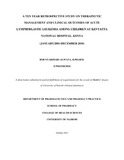| dc.contributor.author | Agwata, Bob N | |
| dc.date.accessioned | 2013-06-03T09:34:36Z | |
| dc.date.available | 2013-06-03T09:34:36Z | |
| dc.date.issued | 2012 | |
| dc.identifier.citation | A dissertation submitted in partial fulfillment oj requirements for the award oj Masters' degree of University of Nairobi (clinical pharmacy) | en |
| dc.identifier.uri | http://erepository.uonbi.ac.ke:8080/xmlui/handle/11295/28663 | |
| dc.description.abstract | In the past three decades, leukemias were considered rare hematological cancers because cases
were sporadic and in places like Africa, where data were lacking, were even considered nonexistent.
Of all types of Leukemia, acute lymphoblastic leukemia is the commonest. Its treatment
outcome and survival rates improved gradually over decades from a mere 30% in the 60's and
70's to approximately 80% currently in most developed countries. This has been due to change
in regimens to newer drugs and improved diagnostic technology, among others. There is limited
data on treatment outcomes of acute lymphoblastic leukemia in the developing countries and
hencethe impetus for the present study.
Objectives
I
To describe the therapeutic management and evaluate the clinical outcomes of acute
lymphoblastic leukemia among children at Kenyatta National Hospital.
Methodology
The study was a descriptive retrospective cohort that followed treatment outcomes from the time
of diagnosis and initiation of treatment. All incident cases of pediatric acute lymphoblastic
leukaemia seen at Kenyatta National Hospital from January 2001 to December 2010 were
reviewed.
Data analysis
Data collected was collected and entered into a database and then exported to SPSS (Version
12.0) for analysis. All variables were subjected to descriptive data analysis. Student t-test and
ANOVAs were used to compare differences-between treatment regimens. Key prognostic factors
and survival were identified using logistic regression modeling.
XlI
Eligibility Criteria
The patients included in this study met the following criteria: Aged between 0- 15 years,
diagnosed with acute lymphoblastic leukemia with confirmatory laboratory tests, diagnosed
between2001 and 2010.
Results: One hundred and seventy one patient medical record files were reviewed. Out of the
171cases, 100(58.5%) were males and 71(41.5%) were females. The mean age at diagnosis was
6.69years (sd ±3.64). Median follow up time was 17.92 months.The most predominant subtype
ofALL was found to be L2-T precursor cell occurring with 137 cases (80.1 %) followed by Ll B
precursor cells with 16 cases (9.4%) while 17 cases (9.9%) were uncharacterised. Mortality was
the most commonly occurring treatment outcome with 110 deaths giving a case fatality rate of
64.3% among childhood cases of acute lymphoblastic leukemia in Kenya. Initial remission
occurred in 105 cases (61.4%). Eighty (46.8%) patients had a relapse, and the commonest site of
relapse was central nervous system with 60 cases (67.4%). Cure rate was 34 cases (22.7%).
Twenty three cases (67.6%) of those that achieved cure were alive while 11 (32.4%) died due to
other causes. Extravasations and treatment failure at the initial stages of therapy rarely occurred.
Among the 171 children with acute lymphoblastic leukaemia, 150 (87.7%) were managed on
KNH 1 regimen. Eight cases (4.7%) were managed using alternative regimens (either KNH 2, n
=2 or "other regimen", n = 6) while 13 (7.6%) had no treatment instituted. The patient
characteristics that showed significant association with mortality as a treatment outcome were:
blood film (p = 0.011), failure to initiate a regimen (p = 0.005), absence of remission (p <
0.0010). Clinical features that showed statistically significant associations with the outcome of
mortality were bleeding (p < 0.001) and splesiomegaly (p = 0.032).
Conclusion: Overall outcome of chemotherapeutic management of acute lymphoblastic
leukaemia was poor. Mortality being the highest, frequent relapse and overall poor cure and
survival rates were noted. There is, therefore, an opportunity to review the management of
patients with acute lymphoblastic leukemia at Kenyatta National Hospital with the aim of
improving treatment outcomes and overall survival. | en |
| dc.language.iso | en | en |
| dc.title | A ten year retrospective study on therapeutic management and clinical outcomes of acute lymphoblastic leukemia among children at Kenyatta National Hospital, Kenya | en |
| dc.type | Thesis | en |
| dc.description.department | a
Department of Psychiatry, University of Nairobi, ; bDepartment of Mental Health, School of Medicine,
Moi University, Eldoret, Kenya | |
| local.publisher | clinical pharmacy, University of Nairobi | en |

